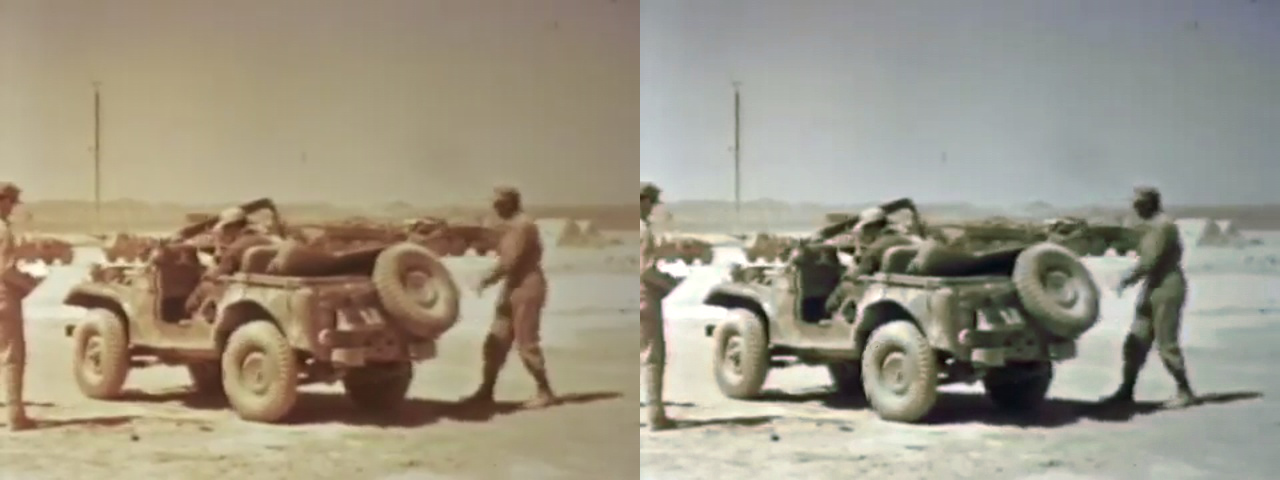 |
| This is the opening scene of Operation TEAPOT Military Effects Studies |
 |
| The operations library symbolizes the growing base of knowledge gained by nuclear testing in Nevada. |
 |
| The 1955 TEAPOT series were a military AFSWP command program. AFSWP is spoken as "aff-swahp." |
 | ||||
TEAPOT was completed during the May desert wildflower bloom. A soldier with the US 4th Army, based out of Fort Sam Houston, TX, inspects construction during Desert Rock VI. A soldier with the US 4th Army, based out of Fort Sam Houston, TX, inspects construction during Desert Rock VI.
8000 Department of Defense troops conducted tactical maneuvering exercises in the vicinities of shots BEE and APPLE II. Observer programs involved shots WASP, MOTH, TESLA, TURK, BEE, ESS, APPLE I, and APPLE II, for a total of approximately 11,700 in DoD participation.
 Extensive instrumentation was always an important part of nuclear testing, to gather data for advancing mathematical models and battlefield applications in blast and radiation physics. Extensive instrumentation was always an important part of nuclear testing, to gather data for advancing mathematical models and battlefield applications in blast and radiation physics.
Wiancko blast gauges were installed in different configurations over varying radial distances from ground zero, in both free-air and near-surface underground tests.

Data of fallout intensity and physical characterics were recorded in this rotating incremental collector, using an electronic aperture, in addition to steel buckets and sticky paper stations.
|
 |
The ESS (Effects Sub-Surface) test device's diagnostic casing is prepared for insertion into the placement shaft, with the center of the device reaching 67 feet/20 meters below ground level.
ESS was an effects test of cratering and ground shock, during early development of hand-portable tactical nuclear munitions.  The 1.2 kiloton ESS device test detonates at the northern end of Yucca Flat, Nevada. Light enough for a single Special Forces demolitions expert to carry in the field, this weapon was sometimes called the "atomic satchel." The 1.2 kiloton ESS device test detonates at the northern end of Yucca Flat, Nevada. Light enough for a single Special Forces demolitions expert to carry in the field, this weapon was sometimes called the "atomic satchel." Much more lighting and other work is needed on this scene. That fingerprint again ... . [FACEPALM] 
Notice the cylindrical U.S. Army "Ridgeway" field caps that dominated the 1950s style, until the Vietnam conflict era. Army Chief of Staff Gen. Matthew B. Ridgeway instituted the uniform regulation changes to include starching and an internal frame, to keep its shape.
 The ESS cratering summary's dynamic diagram shows some color improvement. The ESS cratering summary's dynamic diagram shows some color improvement.
The 4 kiloton HORNET test's 300 foot (90 m) tower was readied for its firing during the Nevada Winter season, with snow on the ground.
Notice the fingerprint smudge left by the film ADD (authorized derivative declassifier) official, in the optical window where the film was transcribed to broadcast tape, when it was sanitized for security release.

The smaller towers next to the 390 foot (120 m) shot tower (right) held materials for effects studies within and close to the nuclear fireball.
MET was 22 kilotons in yield, using a hazardously radioactive U-233/plutonium hybrid core, to save money with less, notoriously expensive plutonium. Uranium-233 always has a U-232 impurity that is a strong gamma ray emitter. These cores required heavily shielded, remote control handling for assembly. 
The 15 kiloton GRABLE shot of Operation UPSHOT-KNOTHOLE 1953 was a proof-test of the 280 mm Mark 9 atomic artillery shell. Burst height was approximately 500 feet / 152 m.
A second objective was a blast effects on military materials and vehicles experiment, to closely examine the hugely destructive precursor (thermal surface) wave phenomenon. Separate black and white oil fogs (far right) tested precursor wave attenuation, but high surface winds caused problems with the experiment, by mixing the two clouds. Low altitude nuclear fireballs generate so much heat, surface soils erupt into the air, in a process called "popcorning." This added dust-loading in the air magnifies the blastwave's hammer-like blow. The HORNET test repeated the ground oil fogs test that failed during GRABLE. 
Characteristically reddish-brown NO2 (nitrogen dioxide) was formed in the oxidation of atmospheric nitrogen in the tremendous heat of the nuclear fireball.
More work is required to clean up this scene. This was only a basic color test.
Sandy soil surfaces explode into the air from the thermal pulses of low bursts radiating at least 11 (dark) -15 (light) cal/cm². The photo is from the 1952 TUMBLER-SNAPPER Dog test (shot 4), when this wave phenomenon was first recorded, moving from left to right. A blast effects smoke generator plume (center) was a common tool to calculate free air overpressures at different locations from ground zero, using technical high speed film techniques.
Operation TUMBLER-SNAPPER Technical Report film

This scene is terribly monotone, and therefore it is difficult to distinguish color regions.
Vehicles in the background also need to be processed, and the mountains up to the right.  The Final TEAPOT Tests 23 March 1955 - 15 May 1955 Defense Nuclear Agency 6013F 
Mannequins represented effects on human subjects. Here masonite figures were unloaded from an M135 truck and film-badged for radiation exposure measurements in a contaminated area.
According to the 6013F DNA report, two crews worked quickly at these tasks, spending 10-15 minutes in the area.  |



No comments:
Post a Comment